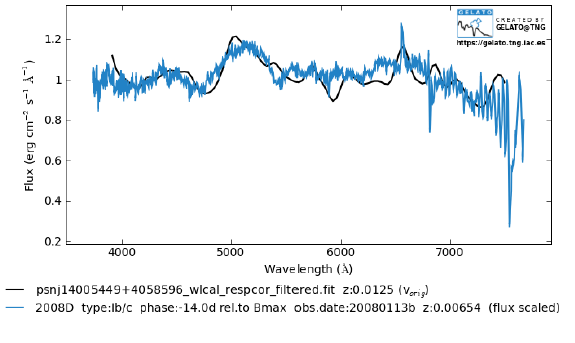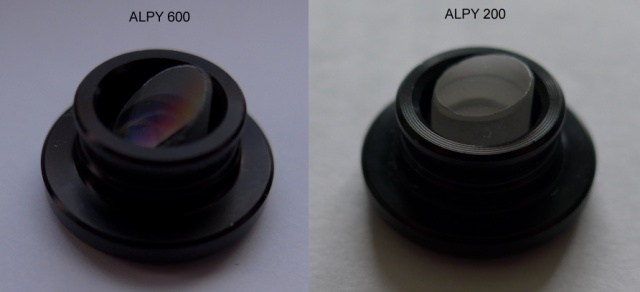
Supernova sn2014AS in NGC 5410 (Formerly PSNJ14005449+4058596) was discovered by amateur Dave Grennan 2014-04-18
This measurement of the spectrum was made 2014-04-26 using a C11 (280mm aperture) with a focal reducer at ~f6 and an ALPY spectrograph fitted with a 200 l/mm grism in place of the standard 600 l/mm. A 23um wide slit was used and the imaging camera was an ATIK 314L+ binned x2 (R~100)
The estimated supernova brightness at this time was ~ mag 16.5 (V unfiltered)
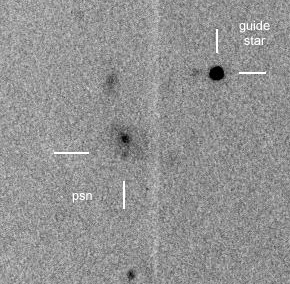
An image of the guider field (ATK16IC-S camera. A stack of 7x 15 sec exposures) The host galaxy is NGC5410 (The image of the slit is blurred because guiding was off during these exposures)
At ~mag 16.5 the sn was much too faint to guide on the slit so a nearby ~mag 13 star was used for guiding with 2sec guiding exposures. (PHD2 guiding software) The sn was placed approximately on the slit and the guide postion was moved in the X direction until the sn appeared at maximum brightness in the zero order image of the slit in the spectrograph camera (60 sec exposures)
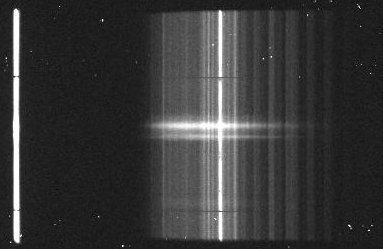
The spectrum image (110 min total exposure time in 10/20 min sub exposures)
The spectrum of the brighter galaxy core can be seen above the supernova spectrum.
Although the observatory is at a reasonably dark rural location the light pollution in the sky background is very obvious in these long exposures. The local lighting is changing from low pressure sodium to metal halide and the change to a more complex line spectrum is clear. (The brightest line is still NaD) The faint molecular bands visible in the red/IR are natural air glow from OH
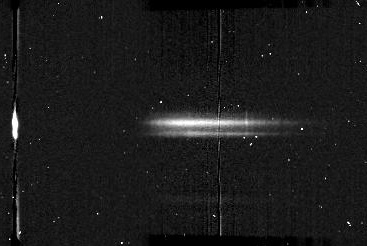
The spectrum image after background subtraction in ISIS. It has done a good job though there is still some residual contamination in the spectra from NaD
Note the clear H alpha emission in the galaxy spectrum
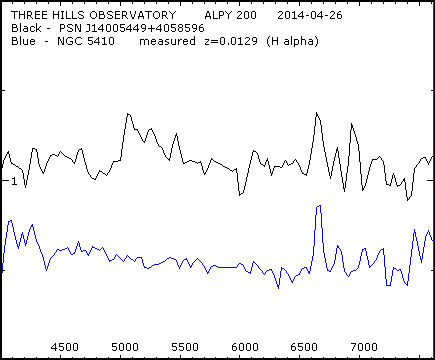
The spectra of the supernova and the galaxy core, corrected for instrument response and atmospheric extinction. The signal/noise in the sne spectrum is ~30 though there are probably larger systematic errors from the sky and galaxy background subtraction. The data points in the contaminated Na D region have been removed
The redshift of NGC5410, measured from the H alpha line is z = 0.0129 compared with a published figure of 0.0124, A remarkably accurate result considering the low dispersion
The supernova spectrum shows no evidence of Si absorption at ~6200A (type 1a) or strong H alpha emission (type II) though there is weak H alpha, possibly contamination from the galaxy spectrum.
On this basis a type 1b or 1c is suspected. This is consistent with the spectrum reported in ATEL 6081
